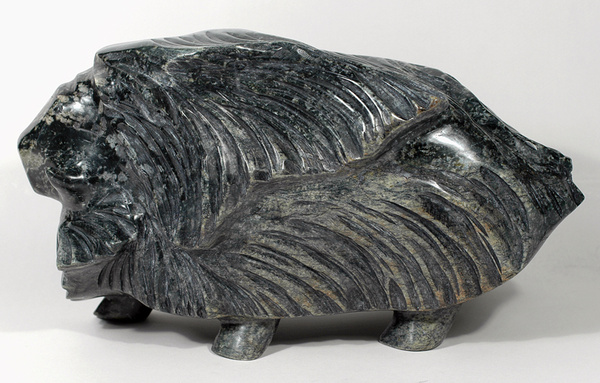Kananginak Pootoogook, R.C.A., (b: 1935, Ikerrasak camp, near Cape Dorset; d: November 23, 2010, Ottawa, Ontario, Canada) was an Inuit sculptor and printmaker who lived in Cape Dorset, Nunavut, Canada. Elected a member of the Royal Canadian Academy of Arts, 1980. Kananginak has been involved with drawing and printmaking since the late 1950's when the graphic arts program first began at Cape Dorset. Kananginak's first print, a collaborative image with his father, Pootoogook, was included in the first catalogued collection of Cape Dorset prints in 1959. Since that time, Kananginak's work has been included in almost every annual collection, and has been interpreted in many different print media - copper engraving, stonecut, stencil, lithography and etching. Kananginak was an accomplished stonecut printmaker himself - in the early years he often proofed and editioned his own work. Kananginak and his siblings grew up in different camp areas on south Baffin Island. Their main camp was Ikirisaq where their father, Pootoogook, was the camp leader. Kananginak married Shooyoo from Cape Dorset in the mid-1950's. They lived at Ikirisaq until 1958 when they moved to Cape Dorset because of Pootoogook's failing health. Kananginak has been a prominent community leader. He was instrumental in the formation of the West Baffin Eskimo Cooperative in 1959, and served for several years as president of its Board of Directors. He is also a member of the Royal Canadian Academy of the Arts. In 1978, four of Kananginak's images were included in a limited edition portfolio released by the World Wildlife Commission. His work has been featured in numerous exhibitions, in both public institutions and commercial galleries. He is also a notable sculptor. In 1997, Kananginak was commissioned by the Governor General of Canada, Romeo Leblanc, to construct an inuksuq in Cape Dorset, which was then dismantled and shipped to Ottawa. Kananginak and his son Johnny were then invited to Ottawa to re-assemble the inuksuq on the grounds of Rideau Hall as part of a tribute to Native people in Canada. From the beginning, Kananginak has represented Arctic wildlife in his work, often monumental in scale. He is especially capable at drawing the many species of birds that frequent the Arctic. He has also done many memorable images illustrating the material culture of the Inuit, and narrative drawings of camp and hunting scenes. Kananginak received the National Aboriginal Achievement Award in the Arts this year, in recognition of his long and illustrious career. He has also been a constant presence in the drawing studio, working on large and small scale drawings of Arctic wildlife, landscape and personal reflections. He is represented in the 2010 print collection with nine images - familiar and reassuring in their style and simplicity. — Dorset Fine Arts (reproduced with permission)


